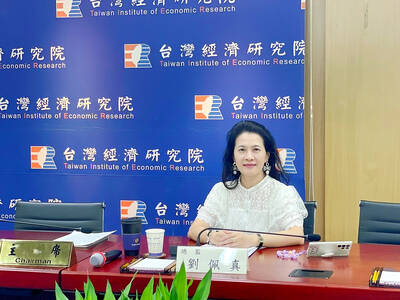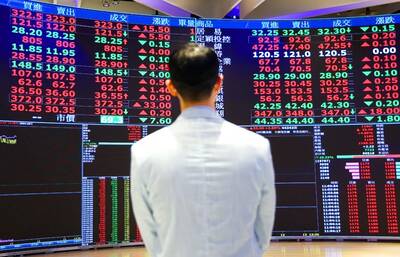Asian markets fell sharply yesterday after Wall Street declined at the end of last week on renewed concerns about US mortgage problems. European markets, however, were mixed in early morning trade.
"Basically, the subprime loan issue still drags on, and there is no prospect of what can end the problem," said Shinichi Ichikawa, chief strategist at Credit Suisse, of the falls in Asian markets.
Major banks warned last week of further losses in their debt portfolios, raising investor concerns that the credit market slump isn't abating.
Taiwan's TAIEX closed down 3.35 percent, Japan's benchmark Nikkei 225 index dropped 2.5 percent, and Hong Kong's Hang Seng fell 3.9 percent. In South Korea, the Korea Composite Stock Price Index, or Kospi, fell 3.4 percent.
Both the Hang Seng and the Kospi fell more than 4 percent during intraday trade, and the Nikkei dipped below 15,000 points for the first time since July last year.
"As for the US economy, the risk of recession is increasing toward the next year amid the lingering subprime loan problems," which, combined with higher oil prices, prompted players to sell the dollar, Ichikawa said.
Japanese traders sold exporter issues on the strengthening yen, which is at its highest levels against the dollar in 18 months. A stronger yen makes exporters' goods less competitive overseas and cuts into their foreign earnings.
In Hong Kong, HSBC shed 2.8 percent on subprime exposure woes.
Chinese financial shares were also lower after China's central bank raised the reserve requirement for banks by 50 basis points to 13.5 percent at the weekend in another of its money-tightening measures.
Meanwhile, European markets opened mixed in early trade yesterday, with Germany's DAX down 0.2 percent, France's CAC 40 down 0.1 percent and Britain's FTSE 100 up 0.7 percent.
In other Asian markets, shares tumbled as well. The Shanghai composite index lost 4.7 percent amid unconfirmed rumors that the China Securities Regulatory Commission recently ordered funds to hold off on aggressive buying.
The benchmark indices also lost ground in Australia, the Philippines and Thailand.

IN THE AIR: While most companies said they were committed to North American operations, some added that production and costs would depend on the outcome of a US trade probe Leading local contract electronics makers Wistron Corp (緯創), Quanta Computer Inc (廣達), Inventec Corp (英業達) and Compal Electronics Inc (仁寶) are to maintain their North American expansion plans, despite Washington’s 20 percent tariff on Taiwanese goods. Wistron said it has long maintained a presence in the US, while distributing production across Taiwan, North America, Southeast Asia and Europe. The company is in talks with customers to align capacity with their site preferences, a company official told the Taipei Times by telephone on Friday. The company is still in talks with clients over who would bear the tariff costs, with the outcome pending further

A proposed 100 percent tariff on chip imports announced by US President Donald Trump could shift more of Taiwan’s semiconductor production overseas, a Taiwan Institute of Economic Research (TIER) researcher said yesterday. Trump’s tariff policy will accelerate the global semiconductor industry’s pace to establish roots in the US, leading to higher supply chain costs and ultimately raising prices of consumer electronics and creating uncertainty for future market demand, Arisa Liu (劉佩真) at the institute’s Taiwan Industry Economics Database said in a telephone interview. Trump’s move signals his intention to "restore the glory of the US semiconductor industry," Liu noted, saying that

NEGOTIATIONS: Semiconductors play an outsized role in Taiwan’s industrial and economic development and are a major driver of the Taiwan-US trade imbalance With US President Donald Trump threatening to impose tariffs on semiconductors, Taiwan is expected to face a significant challenge, as information and communications technology (ICT) products account for more than 70 percent of its exports to the US, Chung-Hua Institution for Economic Research (CIER, 中華經濟研究院) president Lien Hsien-ming (連賢明) said on Friday. Compared with other countries, semiconductors play a disproportionately large role in Taiwan’s industrial and economic development, Lien said. As the sixth-largest contributor to the US trade deficit, Taiwan recorded a US$73.9 billion trade surplus with the US last year — up from US$47.8 billion in 2023 — driven by strong

STILL UNCLEAR: Several aspects of the policy still need to be clarified, such as whether the exemptions would expand to related products, PwC Taiwan warned The TAIEX surged yesterday, led by gains in Taiwan Semiconductor Manufacturing Co (TSMC, 台積電), after US President Donald Trump announced a sweeping 100 percent tariff on imported semiconductors — while exempting companies operating or building plants in the US, which includes TSMC. The benchmark index jumped 556.41 points, or 2.37 percent, to close at 24,003.77, breaching the 24,000-point level and hitting its highest close this year, Taiwan Stock Exchange (TWSE) data showed. TSMC rose NT$55, or 4.89 percent, to close at a record NT$1,180, as the company is already investing heavily in a multibillion-dollar plant in Arizona that led investors to assume